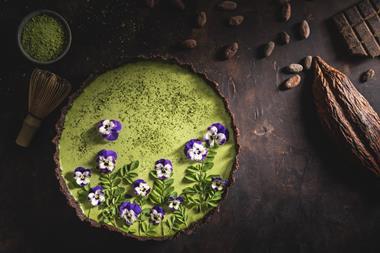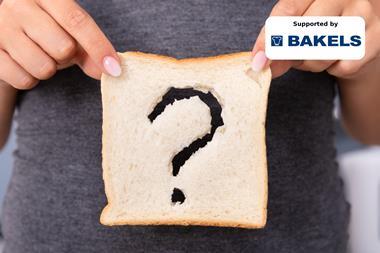As consumers seek more indulgent chocolate products, suppliers are seeking ways to add value, but at what cost to their margins?
Posh chocolates are breaking out of boutiques and heading for the mainstream as Brits seek high-cocoa, single-origin products to satisfy their cravings.
But can bakers translate increased consumer interest in premium chocolate to added value across their ranges?
“The most recent trend was, frankly, taking cost out as a lot of our customers asked us to look at value engineering to mitigate raw material increases,” says Chris Ormrod, Ministry of Cake managing director. “But now we’re living in a period of higher inflation, it’s about what can we do to make our cakes more appealing by adding value to them.”
Higher cocoa content chocolate, of around 70-80%, is a key driver of this, Ormrod notes, adding that his business has had a substantial increase in enquiries from customers versus a year ago.
“We are predominantly making new or upgraded versions of our chocolate fudge cakes, but using Belgian chocolate of a higher cocoa content and cocoa nibs, as opposed to milk chocolate pieces, and that gives a really intense cocoa flavour,” he adds.
The good news, says Gary Wyman, chocolate customer development manager at Puratos (which owns Belgian chocolate brand Belcolade), is that high cocoa content has little or no impact on the baking process. However, it does have a tendency to burn if exposed to direct heat, which can affect the look of the finished product.
%%Quote_7%%
“A higher cocoa content delivers two benefits: the first being a greater hit of chocolate flavour and the second the fact a high cocoa content contains very little cocoa butter. Cocoa butter melts out during many bakery processes and can detract from the final result, so having less of it in a product can be beneficial,” Wyman adds.
Premium ingredients affect costs, of course. “Higher cocoa content adds about 20-25% in additional ingredient costs, but you should be able to recoup that in terms of a higher consumer price,” believes Ormrod.
This is where the argument for using single-origin chocolate in baked goods can fall down, as the costs increase dramatically.
“Changing to single origin is likely to be a problem as prices can be more than double those for standard Belgian couverture,” explains Michael Kamlish, Home Chocolate Factory managing director. Also, securing enough single-origin chocolate to meet demand can be tricky.
However, single origin, believes Puratos’ Wyman, should not be overlooked as it can play an important role in differentiation. “As a lot of the characteristics of single-origin chocolate can be lost during the baking process, it is often better used post-bake as an enrobing component, or as decoration on a cake or muffin, to complement the taste of the baked item,” he adds.
The biggest hurdle, though, is convincing shoppers, as Brits are famed for their love of milk chocolate. “The British consumer is very traditional,” believes Kamlish, “and the use of ‘Belgian chocolate’ is still a more powerful selling point than using Cuban 70% Dark Chocolate, for example.” Particularly when they can have more chocolate for the same price.
%%Quote_8%%
“Consumers are looking for more than value for money when it comes to chocolate bakery items, with indulgence a big sales driver,” says Jacqui Passmore, marketing manager at Dawn Foods UK & Ireland. “Consumers want depth of flavour found in double or triple chocolate muffins or pairing with complementary flavours such as caramel.”
For those seeking more indulgence, both higher cocoa and single-origin chocolate offer an opportunity for added value. But the customer has to be convinced it’s worth it.
Barry Callebaut unveils ruby chocolate
Think there’s only three types of chocolate – white, milk and dark? Think again.
After years of research and development, chocolate manufacturer Barry Callebaut has unveiled ruby chocolate. Made from the ruby cocoa bean, the chocolate is said to have an intense taste that is not bitter, milky or sweet, but is instead “between berry-fruitiness and luscious smoothness”.
Despite its characteristic reddish colour, Barry Callebaut insists no berries or berry flavour, nor colour, have been added. The berry-fruitiness and colour are naturally present, and have been unlocked by the manufacturer through what it describes as an innovative process. It took the work of Barry Callebaut’s R&D centres in France and Belgium, part of a 28-strong network, and the Jacobs University, Bremen, to achieve.
“Ruby chocolate not only satisfies a new consumer need found among millennials – hedonistic indulgence – but also high purchase intent at different price points,” says Peter Boone, Barry Callebaut chief innovation & quality officer.
“We’re looking forward to working with our partners on introducing this innovative breakthrough to the market and making the new ruby chocolate category available to chocolate manufacturers and consumers around the world as the fourth reference next to dark, milk and white chocolate.”
The launch of ruby chocolate, which made its debut in Shanghai, China last month, comes 80 years after white chocolate was introduced to the world. It is expected to be rolled out across different product categories, following in the footsteps of its three predecessors.
While Barry Callebaut says ruby chocolate can be used in a wide variety of applications from moulding to an ice cream coating, it is not recommended for bakery applications as the colour can be lost.





























No comments yet